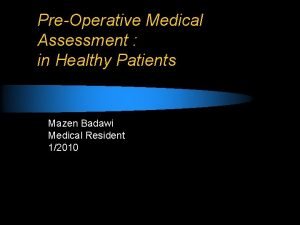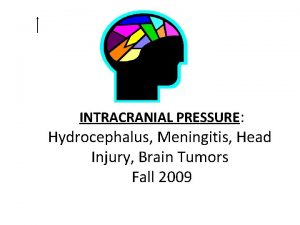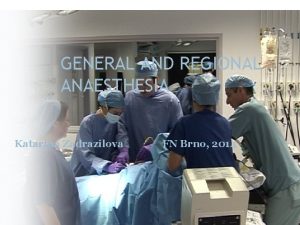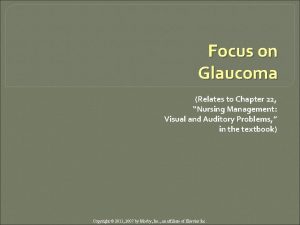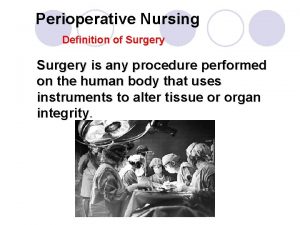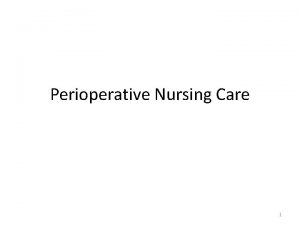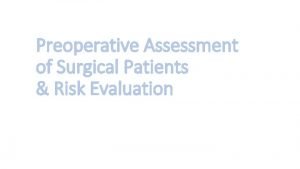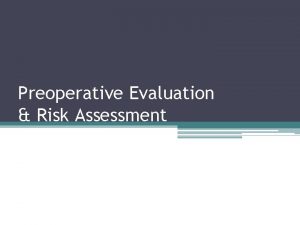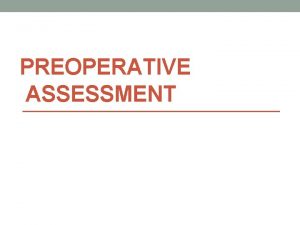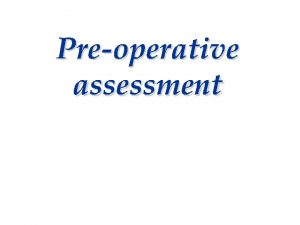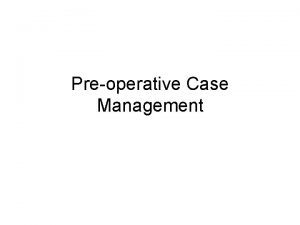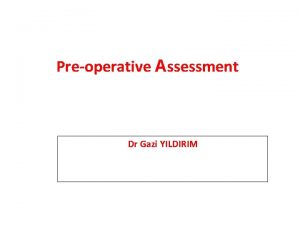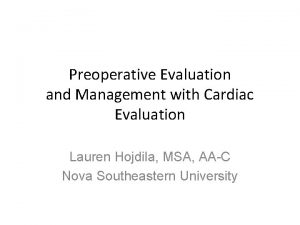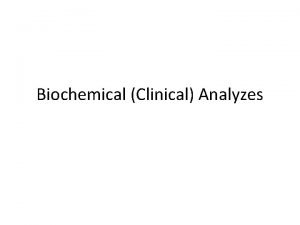Preoperative Evaluation Preoperative Evaluation The clinical foundationframework of
















- Slides: 16

Preoperative Evaluation

Preoperative Evaluation - The clinical foundation/framework of perioperative patient management and has the potential to reduce operative MORBIDY and ENHANCE PATIENT OUTCOMES. - Purpose of evaluation is to obtain pertinent information re the patient’s current and PMHx – and then to formulate an assessment of the patient’s perioperative risk and ways to clinically optimize patient prior to procedure. - Both basic and complex diseases/syndromes that can potentially affect anesthesia periop management require the anesthesiologist to be clinically knowledgeable and current in aspects of the patient’s care. (NOT just passing gas and playing sudoko)

Preoperative Evaluation According to the American Society of Anesthesiologists (ASA), what is the ASA physical status classification of a 70 year old patient with well-controlled HTN treated with an angiotensin receptor blocker? A. ASA 1 B. ASA 2 C. ASA 3 D. ASA 4 Which of the follow descriptions most correctly correlates with an ASA 4 classification? A. T 2 DM with hemoglobin A 1 C of 8. 2% B. Hypertensive patient with chest pain at rest C. Atherosclerotic patient who suffered a CVA 3 years ago D. 83 year old with necrotic bowel and acute on chronic renal failure

Preoperative Evaluation ASA Physical Status ASA 1 Healthy patient without organic, biochemical or psychiatric disease ASA 2 Patient with mild systemic disease (mild asthma, well controlled HTN). No significant impact on daily activity. Unlikely to have an impact on anesthesia and surgery. ASA 3 Significant or severe systemic disease that limits normal activity (renal failure on HD, class 2 CHF). Significant impact on daily activity. Probably impact on anesthesia and surgery ASA 4 Severe disease that is constant threat to life or requires intensive therapy (Acute MI, resp failure requiring mechanical ventilation. Serious limitation on daily activity. Major impact on anesthesia and surgery ASA 5 Moribund patient who is equally likely to die in next 24 hours w/ or w/o surgery ASA 6 Brain-dead organ donor

Preoperative Evaluation Basic components of a preoperative medical history - Previous anesthetics/surgeries - Allergies - Medications - Medical problems - Smoking/Et. OH/illegal drugs - Recent steroid use - Functional levels of exercise (METs) - Recent illnesses - Pertinent family history - Screening ROS (may help diagnose previously undiagnosed conditions)

Preoperative Evaluation Cardiorespiratory fitness - Useful in guiding further preanesthetic evaluations (EKG/stress test etc) - Also in predicting outcomes and periop complications - Exercise/activity can be quantified using metabolic equivalents of the task (METs) which refers to a measure of volume of oxygen consumed during an activity. - Better fitness = decreased mortality, reductions in BP/obesity - Several studies show that inability to perform 4 -5 METs identifies patients at risk for periop complications.

Preoperative Evaluation Physical Exam - Components that we are all taught (systems) - Airway Exam is the most important component of the physical exam from an anesthesiologists perspective. - Components - Length of upper incisors - Condition of teeth. - Relationship of upper to lower incisors - Intercisor distance - Tongue size - Visibility of uvula - Presence or absence of facial hair - TM distance - Length and thickness of neck - ROM

Preoperative Evaluation Mallampati score of 3 or 4 predicts difficult intubation. Others include previous difficult intubation, small mouth opening, reduced TM distance, decreased ROM, inability to prognath.

Preoperative Evaluation of Common Coexisting Diseases Cardiovascular Disease - Most common serious perioperative adverse events. - HTN: 2 or more readings greater than 140/90 mm. Hg. OR for an association between HTN and periop cardiac risk is 1. 31. Generally recommended that elective surgery be delayed for severe HTN (diastolic BP >115 mm. Hg, systolic BP >200 mm. Hg) until BP is less than 180/110 mm. Hg. Should be lowered over weeks, not abruptly. - If significant end-organ damage is present, or intraop hypotension is needed/planned, the goal is to restore BP to normal levels as much as possible prior to surgery. Rapid changes increase risk of cerebral or coronary ischemia

Preoperative Evaluation ACC/AHA algorithm Cardiovascular Disease - Coronary Artery Disease: if history, must review prior caths, prior echo, EKG and current physical status/symptoms (METs >4, chest pain at rest, etc. ) - Preoperative revascularization before noncardiac surgery does NOT improve outcomes. - Noncardiac surgery AFTER revascularization ; patients require antiplatelet therapy - BMS: require at least one month of DAPT; surgery should be delayed at least 30 days after BMS placement - DES: require at least 3 months of DAPT, if risk of delayed surgery is greater than expected risks of in stent thrombosis.

Preoperative Evaluation Cardiovascular Disease - Heart failure; significant risk factor for periop adverse effects - Worse with decompensation (20 -30% incidence of AEs) - Evaluate if systolic, diastolic or both - If decompensated, elective surgeries should be postponed until optimized. - Recommendations for preop evaluation of LV function in table; based on current symptoms and previous evaluations Recommendations for Preoperative Noninvasive Evaluation of LV function CLASS IIa (Reasonable to Perform) 1. It is reasonable for pts with dyspnea of unkown origin to undergo evaluation. 2. Reasonable for patients with current or prior heart failure with worsening dyspnea or other change in clinical status if ECHO hasn’t been performed within 12 months CLASS IIb (May be considered) 1. Reassessment of LV fx in clinically stable patients with previously documented cardiomyopathy is not well established CLASS III (Not be performed because not helpful) 1. Routine periop evaluation of LV fx in patients is not recommended.

Preoperative Evaluation Pulmonary Disease - postoperative pulmonary complications (atelectasis, bronchospasm, pneumonia, exacerbation of chronic symptoms, postop need for mechanical ventilation) increase costs, morbidity rate and mortality risk. - Well-controlled asthma - does not increase periop complications - Poorly controlled asthma – higher risk of complications - COPD – more severe, the greater risk for complications - Corticosteroids and inhaled beta agonists preoperatively decreases risk of bronchospasm after intubation - Brief periop administration of steroids (1 week or less) do not increase risk of postop infections or delay healing - Routine PFTs, chest Xrays or ABGs prior to elective surgery do not predict PPC risk (per Baby Miller page 174) - OSA: STOPBANG; ventilation, DL, intubation all more difficult in these patients. - Should bring CPAP day of procedure

Preoperative Evaluation Renal disease - Associated with HTN, cardiovascular disease, electrolyte disturbances, and variable intravascular volume (dialysis vs overloaded) - For elective cases, dialysis is performed within 24 hours of surgery, but not immediately before. - Chronic hyperkalemia; may not need tx if less than 6 m. Eq/d. L and within patients usual range. - May need to alter type and amount of anesthesia drugs - Succ? Paralysis?

Preoperative Evaluation Diabetic patients - These patients are at higher risk for multiorgan dysfunction, cardiovascular disease, impaired wound healing, - Preoperatively should have a recent EKG, renal function, recent A 1 C, and an understanding of baseline glucose levels. - Important to understand medication regimen. - A good time to ask about metformin - Goals of periop glucose management - Prevent hypoglycemia, ketosis, extreme hyperglycemia Insulin Basal: glargine (Lantus, Basaglar, Toujeo), detemir (Levemir), or degludec (Tresiba) Night before surgery Give 80% of usual dose Rapid acting: aspart (Novolog), lispro (Humalog), Give full dose glulisine (Apidra) Regular: Humulin R, Novolin R, Reli. On R NPH: Humulin N, Novolin N, Reli. On N Give full dose Pre-mixed with regular: Humulin 70/30, Novolin 70/30, Reli. On 70/30 Pre-mixed with rapid acting: Humalog 75/25, Give full dose Humalog 50/50, Novolog 70/30 Concentrated regular UGive full dose 500: Humulin U-500 Day of surgery Give 80% of usual dose HOLD Give 1/2 dose Give 1/4 dose Give 1/2 dose Insulin pump Continue current settings Report to pre-op with pump Inhaled human insulin powder: Afrezza Give full dose HOLD

Preoperative Evaluation

Preoperative Evaluation Preop evaluations and preparation can decrease the risk of complications, improve outcomes and improve patient satisfaction.
 Preoperative medical evaluation of the healthy patient
Preoperative medical evaluation of the healthy patient Clinical evaluation of language fundamentals
Clinical evaluation of language fundamentals Post operative nursing management
Post operative nursing management Cushing's triad
Cushing's triad Chapter 17 preoperative nursing management
Chapter 17 preoperative nursing management Preoperative care ppt
Preoperative care ppt Phases of preoperative care
Phases of preoperative care Nursing assessment for glaucoma
Nursing assessment for glaucoma Perioperative definition nursing
Perioperative definition nursing Pre operative care
Pre operative care Preoperative nursing care for eye surgery
Preoperative nursing care for eye surgery Phản ứng thế ankan
Phản ứng thế ankan Các môn thể thao bắt đầu bằng tiếng đua
Các môn thể thao bắt đầu bằng tiếng đua Sự nuôi và dạy con của hươu
Sự nuôi và dạy con của hươu điện thế nghỉ
điện thế nghỉ Biện pháp chống mỏi cơ
Biện pháp chống mỏi cơ Một số thể thơ truyền thống
Một số thể thơ truyền thống
